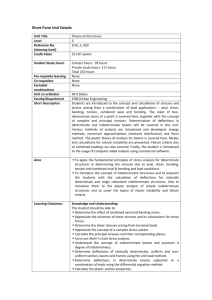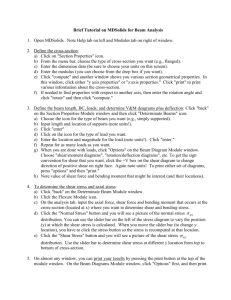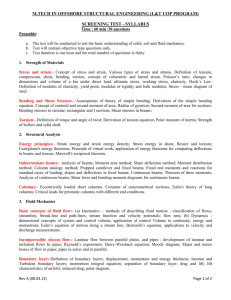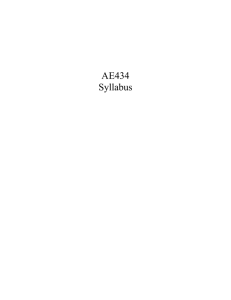Section Forces in Determinate Structures - InRisk
advertisement
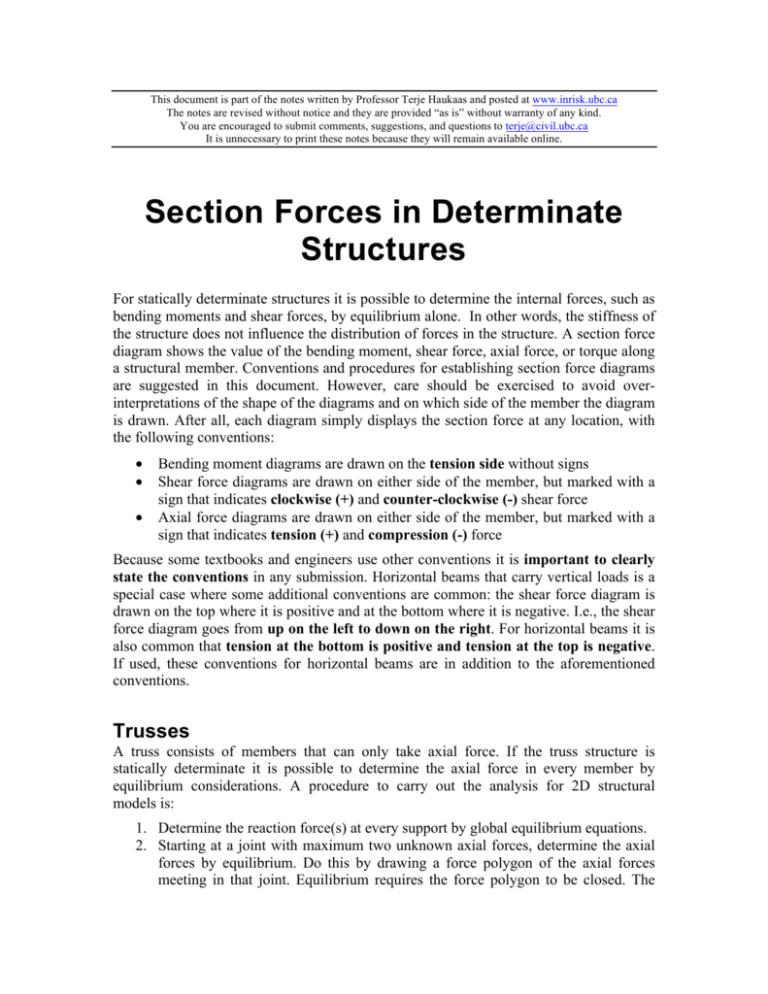
This document is part of the notes written by Professor Terje Haukaas and posted at www.inrisk.ubc.ca The notes are revised without notice and they are provided “as is” without warranty of any kind. You are encouraged to submit comments, suggestions, and questions to terje@civil.ubc.ca It is unnecessary to print these notes because they will remain available online. Section Forces in Determinate Structures For statically determinate structures it is possible to determine the internal forces, such as bending moments and shear forces, by equilibrium alone. In other words, the stiffness of the structure does not influence the distribution of forces in the structure. A section force diagram shows the value of the bending moment, shear force, axial force, or torque along a structural member. Conventions and procedures for establishing section force diagrams are suggested in this document. However, care should be exercised to avoid overinterpretations of the shape of the diagrams and on which side of the member the diagram is drawn. After all, each diagram simply displays the section force at any location, with the following conventions: • • • Bending moment diagrams are drawn on the tension side without signs Shear force diagrams are drawn on either side of the member, but marked with a sign that indicates clockwise (+) and counter-clockwise (-) shear force Axial force diagrams are drawn on either side of the member, but marked with a sign that indicates tension (+) and compression (-) force Because some textbooks and engineers use other conventions it is important to clearly state the conventions in any submission. Horizontal beams that carry vertical loads is a special case where some additional conventions are common: the shear force diagram is drawn on the top where it is positive and at the bottom where it is negative. I.e., the shear force diagram goes from up on the left to down on the right. For horizontal beams it is also common that tension at the bottom is positive and tension at the top is negative. If used, these conventions for horizontal beams are in addition to the aforementioned conventions. Trusses A truss consists of members that can only take axial force. If the truss structure is statically determinate it is possible to determine the axial force in every member by equilibrium considerations. A procedure to carry out the analysis for 2D structural models is: 1. Determine the reaction force(s) at every support by global equilibrium equations. 2. Starting at a joint with maximum two unknown axial forces, determine the axial forces by equilibrium. Do this by drawing a force polygon of the axial forces meeting in that joint. Equilibrium requires the force polygon to be closed. The Terje Haukaas University of British Columbia www.inrisk.ubc.ca direction of the force-arrows determines whether the member is in tension or compression. An arrow towards the joint indicates a member in compression because the equal and opposite force pushes towards the member. 3. Move from joint to joint, always moving to a joint with maximum two unknown axial forces. Frames Frames and continuous beams consists of members that carry load by developing bending moment, shear force, and axial force. For certain statically determinate problems it is possible to determine the section force diagrams simply by recognizing basic beam cases in the structure. In particular, for structures that have cantilevers and simply supported beams, the section force diagrams for those parts are readily known from the basic beam cases. However, in general, fdor statically determinate 2D frames the following procedure is suggested: 1. Determine the reaction force(s) at every support by global equilibrium equations. 2. Determine the bending moment at selected locations: typically member ends and midpoints. Do this by imagining that the member is cut and compute the bending moment that must act on either side of the cut to maintain equilibrium. Sketch the shape of the bending moment diagram by connecting the end points of those lines. The polynomial order of the diagram depends on the load that the member is subjected to; see Table 1 details, which are obtained by solving the differential equation for beams. 3. On another drawing of the structure, sketch the shear force diagram. As shown in Table 1 the polynomial order of the shear force diagram is one less than that of the bending moment diagram. To understand whether the shear force is clockwise or counterclockwise, “walk” along the bending moment diagram from left to right. A downhill walk implies a clockwise shear force. An uphill walk implies a counter-clockwise shear force. This rule is developed by considering equilibrium of an infinitesimal beam. Finally, the actual value of the shear force is obtained from the equilibrium equation V=dM/dx=ΔM/Δx when the bending moment diagram is linear, or more generally by cutting the member and computing the shear force that must act on either side of the cut. 4. The axial force in each member is computed equilibrium at the joints. The sum of the forces in each joint, from shear forces and axial forces, must equal zero. Alternative procedures and habits exist. Some engineers prefer to establish the shear force diagram before the bending moment diagram. In particular, inspired by the information in Table 1, some prefer to establish the shear force diagram by integration of the load, and the bending moment by integration of the shear force. This is rather straightforward for horizontal beams, but cumbersome for general frame structures. For that reason, the general procedure given above is preferred here. Section Forces in Determinate Structures Page 2 Terje Haukaas University of British Columbia www.inrisk.ubc.ca Table 1: Polynomial order of section force diagrams. Load No distributed load Uniform Linear Constant Linear 2nd order Linear 2nd order 3rd order Rotation 2nd order 3rd order 4th order Displacement 3rd order 4th order 5th order Shear force Bending moment Section Forces in Determinate Structures Page 3

